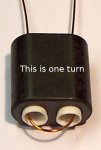G4JNW got me thinking about a "hybrid" log.
While this project is about being totally on ground, how about a hybrid, where part of it is on ground on part is elevated somewhat? That would be interesting to model to make sure it's not a waste of time.
Two options for the 50x25 area just to keep it stealthy and safe:
1) For the "open loop" version, with the feedpoint in a corner of your yard, run the main "U" wire up and along a property fence. The other side of the transformer just has the 25 foot "radial" running / hidden across the ground near your patio.
2) For the true closed loop, do the same - most of the loop is run up and along our property fence, but when it approaches your back step patio, just drop it down to the ground and at one side of the patio is the transformer / feedpoint.
That would really make for an interesting modeling job - I'd just put it up and test it - knowing that perhaps that hybrid technique results in an upward pencil-pointy lobe. I just don't know...
While this project is about being totally on ground, how about a hybrid, where part of it is on ground on part is elevated somewhat? That would be interesting to model to make sure it's not a waste of time.
Two options for the 50x25 area just to keep it stealthy and safe:
1) For the "open loop" version, with the feedpoint in a corner of your yard, run the main "U" wire up and along a property fence. The other side of the transformer just has the 25 foot "radial" running / hidden across the ground near your patio.
2) For the true closed loop, do the same - most of the loop is run up and along our property fence, but when it approaches your back step patio, just drop it down to the ground and at one side of the patio is the transformer / feedpoint.
That would really make for an interesting modeling job - I'd just put it up and test it - knowing that perhaps that hybrid technique results in an upward pencil-pointy lobe. I just don't know...



